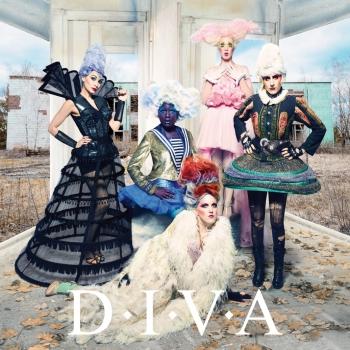D.I.V.A
Biography D.I.V.A
D.I.V.A
So this is the tale of two brilliant singers, strong personalities, and they were performing on various stages in France and elsewhere. They had excellent training — alumni of the Maîtrise de Radio-France — and could sight read any score, even upside down with their eyes closed, they were wary of discovering the real world, where merciless competition makes human feelings seem optional.
In England, Flore Philis had found good productions to appear in, but the rewards were slim when there was an exorbitant rent to consider. Marie Menand was living in the land of Molière and getting by somehow; and she was wondering what she’d let herself in for.
Dreaming of great prime donne’s arias, the two first met in a production of Mozart’s Don Giovanni. Like a pair on a slimming course with their eyes on the desert trolley, they used their imagination and came up with an original project: part opera, part mash-up. The aim was to get everyday listeners to discover opera and fall in love with it, and at the same time, to give themselves the chance to tackle roles they had only dreamed of: Carmen, Violetta or Flora Tosca. And why not Leporello, or Scarpia, too! A project for women thought up by crazies, something more Pedro Almodovar than Ingmar Bergman.
They talked to stage-director Manon Savary about it, and she translated their chimera into something quite visual: five dolls leaving a box wearing crazy wigs, and make-up straight out of the Carnival in Venice. Manon even rummaged through the trunks belonging to her father, the famous French director Jérome Savary, and brought out ve of the most extravagant costumes ever worn by the renowned Grand Magic Circus.
The five dolls would be (allegedly) typecast as Timorous, Snooty, Quirky, Furious and the Ultimate Diva, and appear in an action-packed true story. Each character would sing bits of arias and duets taken from the great repertoire (from The Magic Flute to Tosca), all cleverly cut to shape, scored and orchestrated. In ten minutes! The result would be a brilliant example of direction packed with rhythm, videos and special effects, with no expense(s) spared in production.
One rule only: «Have fun, but don’t betray the music.» So the girls recruited a «magician» to arrange, transpose and shorten the repertoire without alterations: composer Olivier Rabet, who painstakingly concocted admirable scores and even pulled off the miracle of threading a symphony orchestra through the eye of a needle to obtain a string quartet. Four élite musicians, four delicious characters, and a result that some might think a crime, but then again, as the French song has it: La victime est si belle et le crime est si beau.
Marie and Flore went looking for three rare birds — three nightingales as quick on the uptake as three kingfishers (not three birdbrains) — and invited candidates. They received some four hundred and fifty résumés, and went over each one with a fine tooth comb to find a trio with virtuoso vocal chords who were easy-going by nature and also had a sense of humour. The three would have to be divas on the stage, not off it.
Marie and Flore set their hearts on Jazmin Black-Gromellund, a velvet-toned American singer who’d just settled in Belle-Ile-en-Mer, where she had found true love. And they constantly wooed Audrey Kessedjian who, finally convinced, joined them at last. Audrey is a superb mezzo of Armenian origin; after a lightning-fast initial career that was extremely conducive to stress, she had turned to a new type of employment that applied Chinese medicine to horses! Their last find was Grace Carter, an English former pianist finishing her Master’s in opera and piano at Trinity College; a pianist could turn out to be useful in an operatic troupe, but someone who really knew how to make tea might be vital.
Our two «company directors» soon found themselves in charge of a business that wasn’t turning a pro t, and they learnt much about team-management and rehearsal-planning at levels that were more or less industrial. Determined not to cut corners when it came to standards of quality, they persuaded Baptiste Chouquet, the sound engineer from Le Balcon, to imagine a light halo in sound, a veil as natural as possible, to delicately blend voices and instruments together in the absence of a conductor. Note that when Marie and Flore were recording, they drew the line at using headsets — this wasn’t pop — so that they could breathe together, as in chamber music.
If Rabelais had said that humour (not science!) without a little love was no more than the ruin of the soul — if you have no qualms over transgressing sounds then you might as well paraphrase a literary reference —, our gorgeous eccentrics decided to go one step further and got in touch with SKIN, a charity helping women through art after breast cancer. Nine SKIN ladies sang the Barcarolle from Offenbach’s Tales of Hoffmann for a concert with D.I.V.A . It was a source of unutterable joy for all concerned, and at the same time it revived the essence of the entire project.
Before going out to conquer the world with a real ambition they found themselves a name: D.I.V.A. You can call them whatever you like: Distinguished, Irresistible, Vivacious and Amorous, or Dull, Insipid, Vain and Acid! But whatever you call them, please, be polite. And go and hear them, because they’re so talented that with just one top F they could bring the house down.











